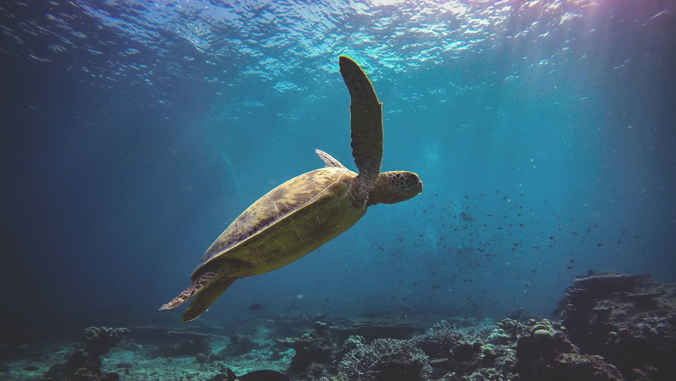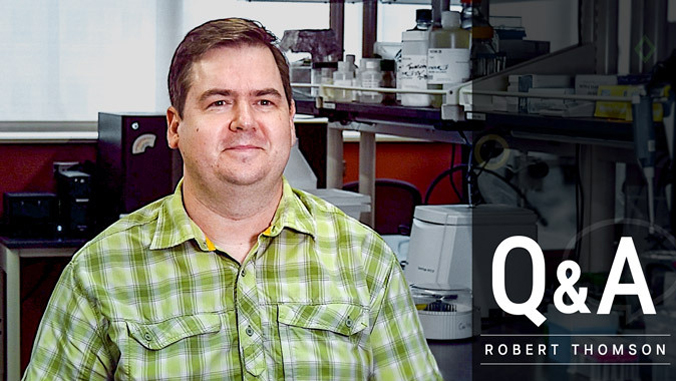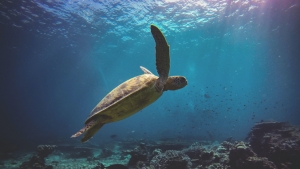

World Turtle Day is May 23. University of Hawaiʻi at Mānoa School of Life Sciences Professor Robert Thomson is an expert on evolutionary and conservation biology, and much of his research focuses on the evolutionary history of turtles. Thomson shared his thoughts on World Turtle Day, and the challenges turtles are facing in Hawaiʻi and around the world.
Why should turtles be celebrated?

It’s an opportunity to recognize an important component of biodiversity that often gets ignored. Something to know about turtles is that they’re both extraordinarily ancient—older than dinosaurs, they’re older than mammals, birds, almost any other vertebrate you’ll see on the Hawaiian landscape—and they’re extraordinarily endangered. Around 60% of species are threatened with extinction today.
Your previous research highlights that turtles face a “daunting future.” What are the biggest threats to their survival today?
There’s two major threats in particular and they’re threats that are shared by a lot of biodiversity today. One is loss of habitat. Turtles have a lot of their species richness on coastlines, in rivers and other aquatic habitats that humans tend to modify and degrade in important ways. Because of this, turtles are experiencing wholesale habitat loss at an enormous scale for the last century. The second thing that influences turtle conservation is collection—both for pet trade and the food trade, as well as traditional cultural uses.
Can you explain how climate change is affecting turtle populations, especially here in Hawaiʻi?
As global sea levels rise, they’re losing nesting beaches, places where they lay their eggs. A recent example of that happened in 2018. In the Northwest Hawaiian Islands, there’s a particular islet in French Frigate Shoals called East Island, that was the nesting area for around 95% of all green sea turtles in Hawaiʻi. It’s a huge amount of the population. A major storm came through and wiped that island off the map. It was gone. That led to a lot of concern that this is the sort of thing we expect to see as the climate continues to change and storms become more powerful and sea levels rise. The good news, at least in the short term, is the island is now reforming. Crews went out last year, and that island once again exists, and it has turtles nesting on it.
How hopeful are you that conservation efforts can help turtle populations in the future?
This is the big question in biodiversity conservation. The hope comes from the idea that this is no longer a scientific mystery. We know what is causing the declines, and in many cases we know how to fix them. We need to protect habitats. We need to restore habitats. We need to stop market trade. The question is whether there is societal and political will to deal with these problems that we already have solutions for, and will we do that quickly enough before these declines turn into extinctions.
Turtles have been around for millions of years. What can they teach us about resilience, survival or even vulnerability in today’s world?
This is a lineage that has existed for 200 million years. That’s a length of time that we truly can’t comprehend. Now, just in the last few centuries, we’re seeing dramatic extinctions and global endangerment. So it shows the impact that humans are having on natural environments and on biodiversity broadly. If this lineage that has been stable and resilient through hundreds of millions of years—through the mass extinction that killed the dinosaurs—is suddenly globally endangered, that speaks to the severity of the impacts that we are having on native ecosystems.
What can people do to help protect turtles and their habitats, both in Hawaiʻi and globally?
You can use what tools you have available to you to support wildlife conservation, particularly habitat conservation. I think in the United States, there’s not many people participating in turtle markets anymore other than in the pet trade, so this issue sometimes gets ignored. But there is still significant commercial collection of turtles that, in turn, get shipped to market in other countries. Wild populations can not sustain this. Other than that, the biggest messages are the same messages as support for biodiversity conservation generally: protecting habitats, advocacy for sustainable systems and voting in ways that help save ecosystems.

